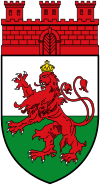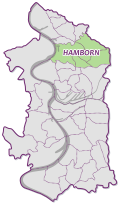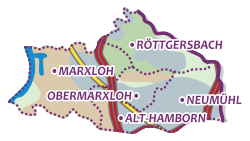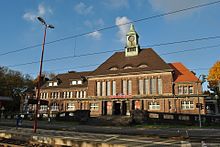Hamborn
|
|||
|---|---|---|---|
| coat of arms | map | ||

|

|
||
| structure | |||

|
|||
| Basic data | |||
| Area : | 20.84 km² | ||
| Residents : | 76,144 (December 31, 2016) | ||
| Population density : | 3,654 inhabitants / km² | ||
| Postcodes : | 47166, 47167, 47169 | ||
| Telephone code : | 0203 | ||
| Distribution of seats for the district council (2014) | |||
|
|||
Hamborn is a district of the independent city of Duisburg in North Rhine-Westphalia . It comprises the districts of Alt-Hamborn, Marxloh , Neumühl , Obermarxloh and Röttgersbach and has 76,144 inhabitants (as of December 31, 2016) on an area of 20.84 km² . Until the merger with the urban district of Duisburg in 1929 to form Duisburg-Hamborn , Hamborn was an independent urban district and at that time was one of the 40 largest cities in Germany.
history
The place Hamborn is mentioned as early as 962 as Havenburn , which means something like "cattle trough". It was named after a Havenburen manor located at the current location of the St. Johann Abbey . In 1136 noble Gerhard von Hochstaden donated this property to the Archbishop of Cologne with the condition that a Premonstratensian monastery be built there. The monastery itself was founded by the Steinfeld Abbey in the Eifel . The settlement and the neighboring farmers belonged to the Duchy of Kleve and came with this to Brandenburg / Prussia in 1614/1666 . At the beginning of the 19th century Hamborn was a small town within the mayor's office Holten in the district of Dinslaken , from 1823 district of Duisburg and from 1873 district of Mülheim an der Ruhr . In 1886 Hamborn became part of the mayor's office Beeck and in 1887 came with her to the newly formed Ruhrort district , which was renamed the Dinslaken district again in 1909 after Ruhrort and Meiderich left.
On April 6, 1898, the Hamborn town council decided to introduce a weekly market, so that from then on the traders set up their stalls on the Altmarkt . In 1900 the Hamborn mayor's office was formed. It included the farming communities Alsum , Bruckhausen, Marxloh , Hamborn-Wittfeld, Schmidthorst, Neumühl and Fahrn .
The expanding industry created new jobs. Hamborn experienced an immense increase in citizens in the following years. On April 1, 1900, Hamborn had around 28,000 inhabitants. In 1910, the population of the young community with Helene Kropp, after whom a street is named, already exceeded the 100,000 mark. On April 1, 1911, 102,800 citizens were counted in Hamborn, which corresponds to an increase of 75,000 new citizens in just ten years. The "largest village in Prussia " was in fact a large city without having had any rights as a city until then . Hamborn received these rights on April 1, 1911. On May 1, 1911 Hamborn left the district of Dinslaken and became an urban district .
In order to prevent the threatened incorporation into Duisburg , Hugo Rosendahl, as Hamborner's mayor, tried unsuccessfully in the 1920s to incorporate the cities of Dinslaken and Sterkrade . Lot of Duisburg is the solution. Shout it out all over the world: Go on from Duisburg the slogan while our chests are still swelling ... so it says in a contemporary poem from 1931, after Hamborn with the city of Duisburg and the towns of Huckingen , Mündelheim and Rahm from the Angermund office in the Düsseldorf district was combined to form the new city of Duisburg-Hamborn , which was then renamed Duisburg on April 1, 1935 . Hamborn has been run as a district since then .
Given the revised municipal code were in all urban districts of North Rhine-Westphalia from 1975 municipalities set up. Even before the new version of the municipal code there was a statistical city district of Hamborn. Bruckhausen and the old Fahrn were separated from the newly established city district . The districts of Alt-Hamborn, Marxloh , Neumühl , Obermarxloh and Röttgersbach remained . Bruckhausen was added to the Meiderich-Beeck district and the old Fahrn to the Walsum district.
All of Duisburg's city districts have their own district representatives with a district chairman at the top. Heinrich Hamacher (1916–1986, SPD ), who held this position until his death on May 21, 1986, became the first district chairman after the municipal reorganization in 1975 . After his death, the deputy district chairman Karl-Georg Hellbach (1922–2008, CDU ) took over this office for a short time before Inge Riederer (* 1927, SPD), wife of the SPD member of the state parliament Anton Riederer , was district chairwoman of Hamborn from 1986 to 1994 . Her successor as district head from 1994 to 2004 was Winfried Besold (1933–2008, SPD), who succeeded Heinrich Hamacher in 1986 as a member of the district council. After the local elections on September 26, 2004 , Uwe Heider (* 1955, SPD) became district chairman and, since 2014, district mayor of the Hamborn district. On February 28, 2019, he resigned his office as district mayor, whereupon the previous 1st deputy district mayor Marcus Jungbauer (* 1971, CDU) became Hamborn's new district mayor on March 28, 2019 as his successor.

coat of arms
Blazon : The coat of arms of the former city of Hamborn shows a silver (white) and green shield with a cross-sectioned shield, a soaring, two-tailed, crowned red lion turned to the right. The upper coat of arms shows a red wall crown with three towers. Meaning: The coat of arms is slightly modified from the coat of arms of the Lords of Horst. Alexander von Horst was abbot in Hamborn from 1782 to 1790. The coat of arms was used in this form from 1911 to 1929. Because of the subsequent incorporation to Duisburg, approval of the coat of arms was never applied for by the district president. The coat of arms adorned official documents of the city of Hamborn. In some variations, the lion holds sticks and irons, symbols of mining, in his paws.
Population development
The following overview shows the population of the municipality of Hamborn (from 1910 a major city ) according to the respective territorial status. These are estimates, census results (¹) or official updates by the respective statistical offices or the city administration itself. From 1843, the information relates to the "local population" and from 1925 to the resident population . Before 1843, the number of inhabitants was determined according to inconsistent survey methods. Hamborn has been part of the city of Duisburg since August 1, 1929. At the 1970 census, the borough had a population of 112,946.
|
|
¹ census result
Today's Alt-Hamborn district has 11,824 inhabitants (as of December 31, 2016).
Lord Mayor
City of Hamborn
- 1911–1919: Friedrich Schrecker
- 1919–1920: Paul Mülhens
- 1921–1929: Hugo Rosendahl , center
City of Duisburg-Hamborn
- 1929–1933: Karl Jarres , DVP (previously Lord Mayor of Duisburg)
- 1933–1934: Ernst Heinrich Kelter
- 1934–1935: Just Dillgardt , NSDAP (then Lord Mayor of the City of Duisburg)
Culture and sights
traffic
The Duisburg-Hamborn train station is on the Walsumbahn . The local rail transport was discontinued in 1983.
literature
see also the literature given under the headings Duisburg , Marxloh and Neumühl .
- Erich Binder: The Ev. Hamborn parish. A contribution to the history of the church in Duisburg-Hamborn . Duisburg 1972
- History of the Protestant parish Hamborn including the hospital . o. O. [approx. 1928]
- Ulf Hegewald (ed.): The Duisburg project. Students of the Aachen University of Applied Sciences draw and paint in Duisburg-Hamborn . Aachen 1984
- Erhard Lucas Two forms of radicalism in the German labor movement . Frankfurt am Main 1976
- Fischer-Eckert, Li: The economic and social situation of women in the modern industrial town of Hamborn in the Rhineland. Hagen 1913
- Rhenish town book . Volume III.3, partial volume from the German city book. Handbook of urban history , on behalf of the working group of historical commissions and with the support of the German Association of Cities, the German Association of Cities and the German Association of Municipalities ed. by Erich Keyser, Stuttgart 1956
- M. Schulte: Ev. Hamborn parish . Duisburg 1929
Born in Hamborner
- Daniel Morian (1811–1887), mining entrepreneur and councilor
- Johannes Kellinghaus (1881–1956), First Mayor of the city of Osterfeld
- Friedrich Stoffels (1898–1944), Jehovah's Witness, victim of Nazi war justice
- Fritz Ketz (1903–1983), painter and graphic artist
- Rudolf Stampfuß (1904–1978), prehistoric
- Karl-Heinz Stroux (1908–1985), actor, director and theater manager
- Friedrich Borges (1909–1975), politician (SPD)
- Matthias “Mattes” Billen (1910–1989), national soccer player
- Karl Rainer (1910–1999), painter, industrial graphic artist and art teacher
- Paul Zielinski (1911–1966), national soccer player, participant in the 1934 World Cup in Italy
- Heinz Trökes (1913–1997), painter and graphic artist
- Hanns-Heinz Bielefeld (1918–2018), politician
- Walter Schädlich (1922–2016), national handball player, sports teacher
- Ursula Wölfel (1922–2014), children's book author
- Ernst Kozub (1924–1971), hero tenor
- Frithjof Elmo Porsch (1924–2015), writer
- Heinrich Schepers (1925–2020), philosopher and Leibniz specialist
- Karlheinz Hoffmann (1927–2012), Jesuit and journalist
- Gisela Hundertmarck (1930–1997), educational scientist
- Manfred Deckers (1934–2020), mining scientist and university professor
- Jacques Berndorf (* 1936) (actually Michael Preute), journalist and writer
- Ludger Horstkötter (* 1939), Roman Catholic clergyman and historian
- Walter Hellmich (* 1944), football official and building contractor
- Werner Scholz (* 1944), soccer player and coach
- Johannes Pflug (* 1946), SPD member of the Bundestag
- Hanns Heinrich Schumacher (* 1948), diplomat and ambassador
- Karl A. Lamers (* 1951), CDU member of the Bundestag
- Clemens Dölken (* 1956), Roman Catholic clergyman
- Sabine Weiss (* 1958), 1999–2009 mayor of the city of Dinslaken and member of the Bundestag
- Albert Thomas Dölken (* 1960), Abbot of Hamborn
- Sören Link (* 1976), SPD member of the state parliament, Lord Mayor of Duisburg
Web links
- District website
- District Office Hamborn ( Memento from May 24, 2009 in the Internet Archive )
- Current information about Hamborn
- Chronicle of Duisburg-Hamborn
- Chantry of the Friedenskirche Hamborn
- Historical data collection on Hamborn
- Map of the borough at OpenStreetMap
- Duisburg Monument Themes No. 11 - Alt-Hamborn / Marxloh (PDF)
Individual evidence
- ↑ Population statistics of the city of Duisburg from December 31, 2016 ( Memento from January 24, 2017 in the Internet Archive ) (PDF; 21 kB)
- ^ Books.google.de Westermanns Historischer Weltatlas.
- ^ Hermann Kewitz: Duisburg . Moving times - The 50s, Spangenberg 1997, ISBN 3-86134-385-1 , p. 41.
- ↑ a b c d Christian Balke: Stadium made of sweat and passion. In: WAZ (Online) from April 12, 2013.
- ^ Heinrich Hamacher on the homepage of the SPD Duisburg
- ^ Mourning for Hellbach , in: Rheinische Post from August 15, 2008.
- ^ Karl Georg Hellbach is dead , in: Westdeutsche Allgemeine Zeitung of August 15, 2008.
- ^ Inge Riederer on the homepage of the SPD Duisburg
- ↑ City and SPD mourn Winfried Besold . In: Westdeutsche Allgemeine Zeitung. January 29, 2008.
- ↑ DISTRICT MAYOR UWE HEIDER TAKES A LOOK BACK AND LOOK OUT. "I get a lot on the cake here" . In: Local compass. 5th January 2019.
- ↑ The Hamborner District Mayor Uwe Heider resigns . In: Westdeutsche Allgemeine Zeitung. 19th January 2019.
- ↑ NEW DISTRICT MAYOR. Marcus Jungbauer (CDU) becomes district mayor in Hamborn . In: Westdeutsche Allgemeine Zeitung. March 28, 2019.
- ↑ POLITICAL EARTHQUAKE IN HAMBORN. Marcus Jungbauer (CDU) is the new district mayor . In: Local compass. March 28, 2019.
- ^ Heinrich Wuwer: 100 years of elevated railway. The railway line Oberhausen - Hamborn - Walsum - Möllen - Spellen - Wesel . Ed .: Heimatverein Voerde. Voerde 2013, p. 101 .
Coordinates: 51 ° 30 ' N , 6 ° 47' E







